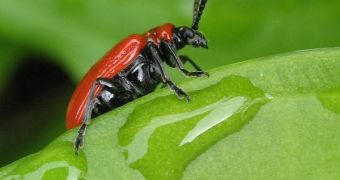Scientists have been recently able to create a new type of material, that is capable of adhering to a large number of other surfaces, using nothing but a mechanism that was derived from the one the leaf beetle employs to stay attached to the leaf. In addition to being able to mimic nature in this regard, the investigators have also been able to suspend small payloads on the new devices, which function via the adhesive force, Nature News reports.
The new device was created at the Ithaca, New York-based Cornell University. Bioengineering experts Michael Vogel and Paul Steen looked at the leaf beetle, and determined that it managed to stay attached to a surface by controlling the combined surface tension of many water drops working together. The force thus produced is enough to hold in place a weight 100 times heavier than the mass of the beetle itself. “It's an example of things to come. We might have something [commercial] in five years using these types of controllable capillary surfaces,” Steen reveals.
The artificial device consists of a small plate, with many holes punctured through it. As liquid is pumped through them, the droplets that are formed on the other side create “liquid bridges” that enable the plate to remain attached to a large array of surfaces. Additionally, the CU research team has already demonstrated that small payloads can be attached to the plate, thus opening the way for new applications based on the technology. Details of the amazing investigation appear in the latest issue of the respected journal Proceedings of the National Academy of Sciences (PNAS).
This specific type of beetle employs a mechanism similar to the one the gecko uses to stay attached even to glass, but the difference is that the gecko resorts to dry capillary forces known as van der Waals forces for securing itself to surfaces. Thousands upon thousands of nanofibers adorn the gecko's feet, and they are able to produce sufficient force to keep the animal secured even to mirrors. In their investigation, Vogel and Steen managed to produce a device that required no moving parts, which considerably advances the array of fields it could be employed in.

 14 DAY TRIAL //
14 DAY TRIAL //